Business Case for the New Technique and Prosthesis
VerifiedAdded on 2023/01/20
|13
|3581
|70
AI Summary
This document discusses the business case for the new technique and prosthesis in knee replacement surgery, including evidence to support its use, identification and rating of risks and benefits, clinical factors considerations, financial impact, and recommendations for adoption. It emphasizes the need for expertise and training in the new technology and highlights the potential benefits for patients and the health facility.
Contribute Materials
Your contribution can guide someone’s learning journey. Share your
documents today.
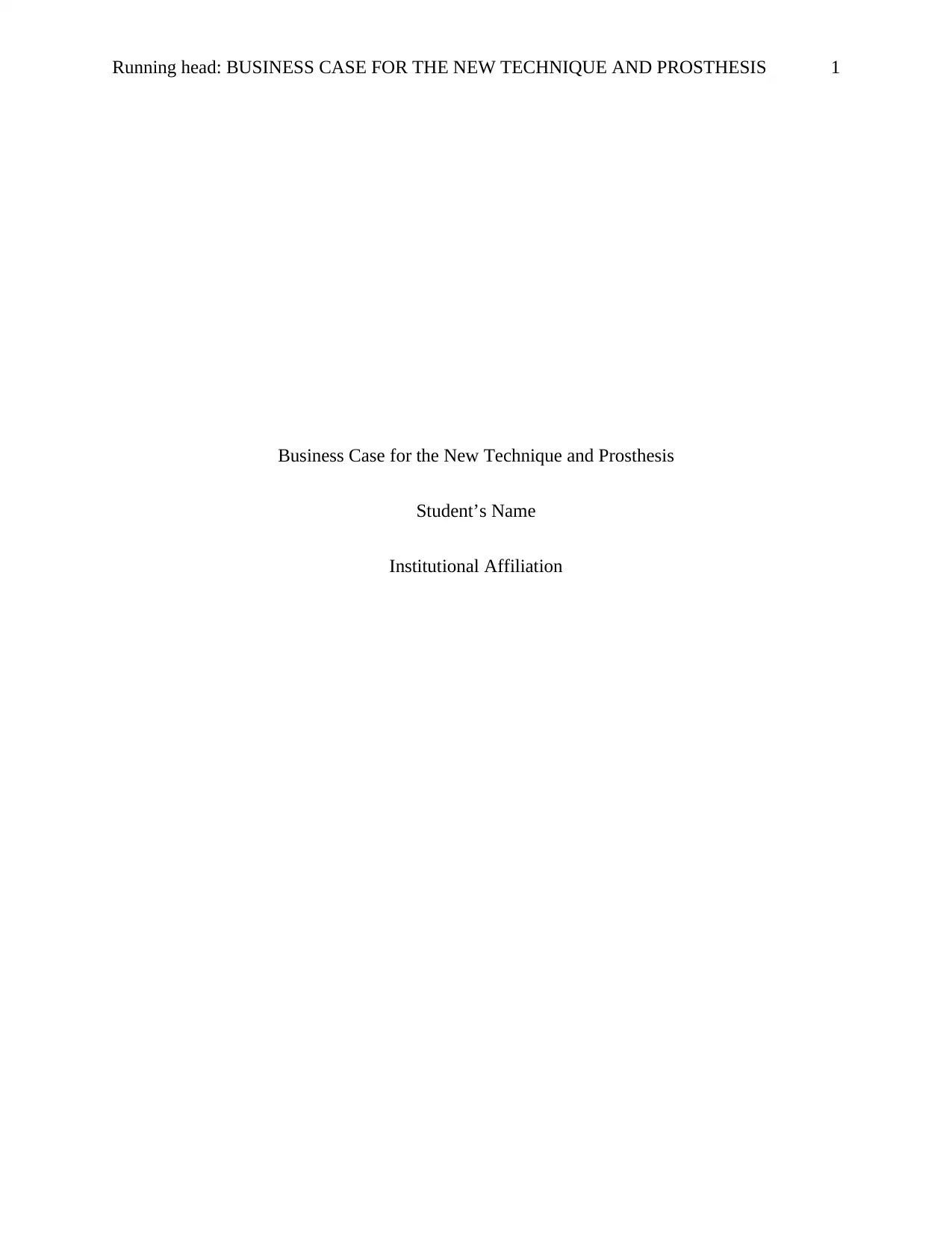
Running head: BUSINESS CASE FOR THE NEW TECHNIQUE AND PROSTHESIS 1
Business Case for the New Technique and Prosthesis
Student’s Name
Institutional Affiliation
Business Case for the New Technique and Prosthesis
Student’s Name
Institutional Affiliation
Secure Best Marks with AI Grader
Need help grading? Try our AI Grader for instant feedback on your assignments.
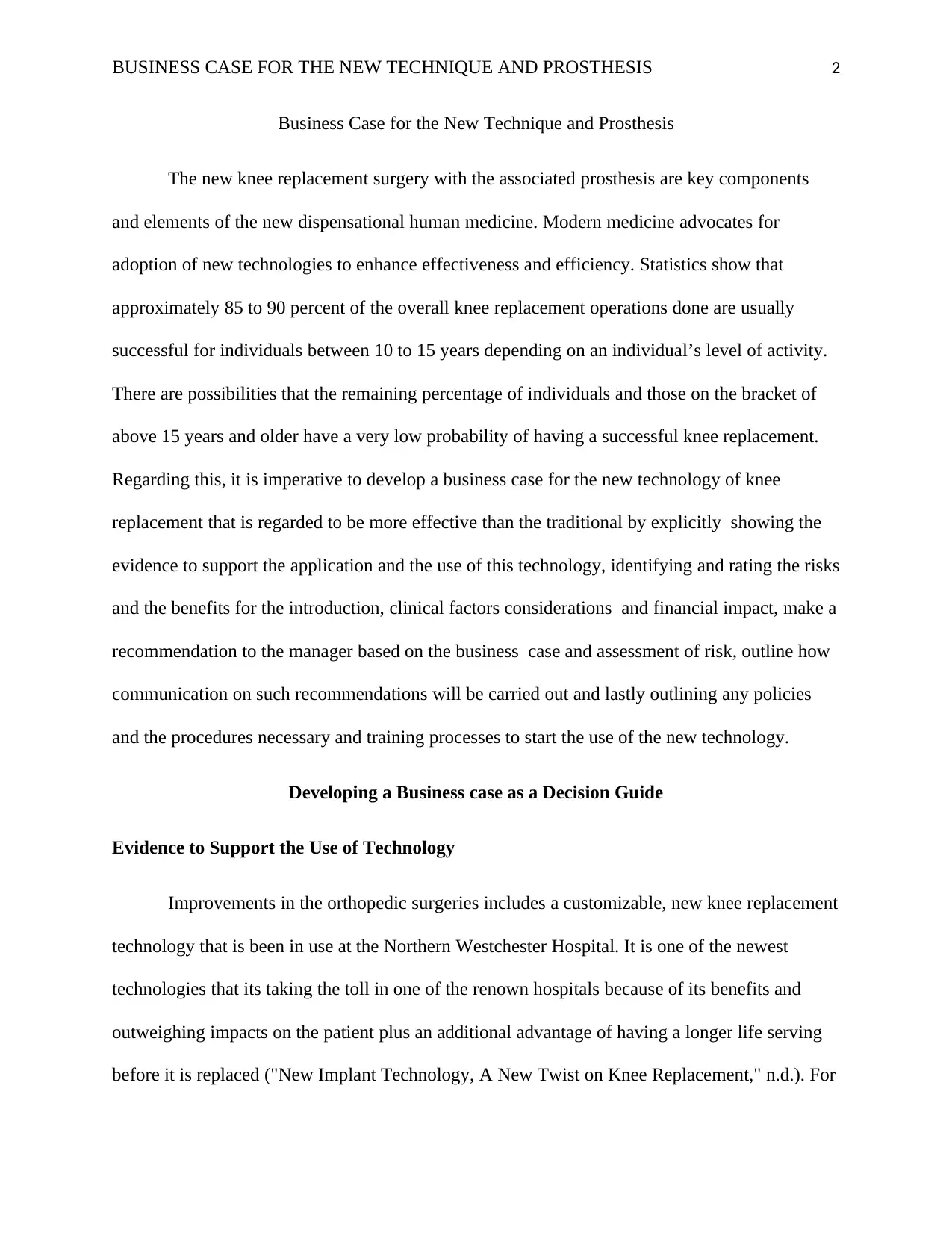
BUSINESS CASE FOR THE NEW TECHNIQUE AND PROSTHESIS 2
Business Case for the New Technique and Prosthesis
The new knee replacement surgery with the associated prosthesis are key components
and elements of the new dispensational human medicine. Modern medicine advocates for
adoption of new technologies to enhance effectiveness and efficiency. Statistics show that
approximately 85 to 90 percent of the overall knee replacement operations done are usually
successful for individuals between 10 to 15 years depending on an individual’s level of activity.
There are possibilities that the remaining percentage of individuals and those on the bracket of
above 15 years and older have a very low probability of having a successful knee replacement.
Regarding this, it is imperative to develop a business case for the new technology of knee
replacement that is regarded to be more effective than the traditional by explicitly showing the
evidence to support the application and the use of this technology, identifying and rating the risks
and the benefits for the introduction, clinical factors considerations and financial impact, make a
recommendation to the manager based on the business case and assessment of risk, outline how
communication on such recommendations will be carried out and lastly outlining any policies
and the procedures necessary and training processes to start the use of the new technology.
Developing a Business case as a Decision Guide
Evidence to Support the Use of Technology
Improvements in the orthopedic surgeries includes a customizable, new knee replacement
technology that is been in use at the Northern Westchester Hospital. It is one of the newest
technologies that its taking the toll in one of the renown hospitals because of its benefits and
outweighing impacts on the patient plus an additional advantage of having a longer life serving
before it is replaced ("New Implant Technology, A New Twist on Knee Replacement," n.d.). For
Business Case for the New Technique and Prosthesis
The new knee replacement surgery with the associated prosthesis are key components
and elements of the new dispensational human medicine. Modern medicine advocates for
adoption of new technologies to enhance effectiveness and efficiency. Statistics show that
approximately 85 to 90 percent of the overall knee replacement operations done are usually
successful for individuals between 10 to 15 years depending on an individual’s level of activity.
There are possibilities that the remaining percentage of individuals and those on the bracket of
above 15 years and older have a very low probability of having a successful knee replacement.
Regarding this, it is imperative to develop a business case for the new technology of knee
replacement that is regarded to be more effective than the traditional by explicitly showing the
evidence to support the application and the use of this technology, identifying and rating the risks
and the benefits for the introduction, clinical factors considerations and financial impact, make a
recommendation to the manager based on the business case and assessment of risk, outline how
communication on such recommendations will be carried out and lastly outlining any policies
and the procedures necessary and training processes to start the use of the new technology.
Developing a Business case as a Decision Guide
Evidence to Support the Use of Technology
Improvements in the orthopedic surgeries includes a customizable, new knee replacement
technology that is been in use at the Northern Westchester Hospital. It is one of the newest
technologies that its taking the toll in one of the renown hospitals because of its benefits and
outweighing impacts on the patient plus an additional advantage of having a longer life serving
before it is replaced ("New Implant Technology, A New Twist on Knee Replacement," n.d.). For
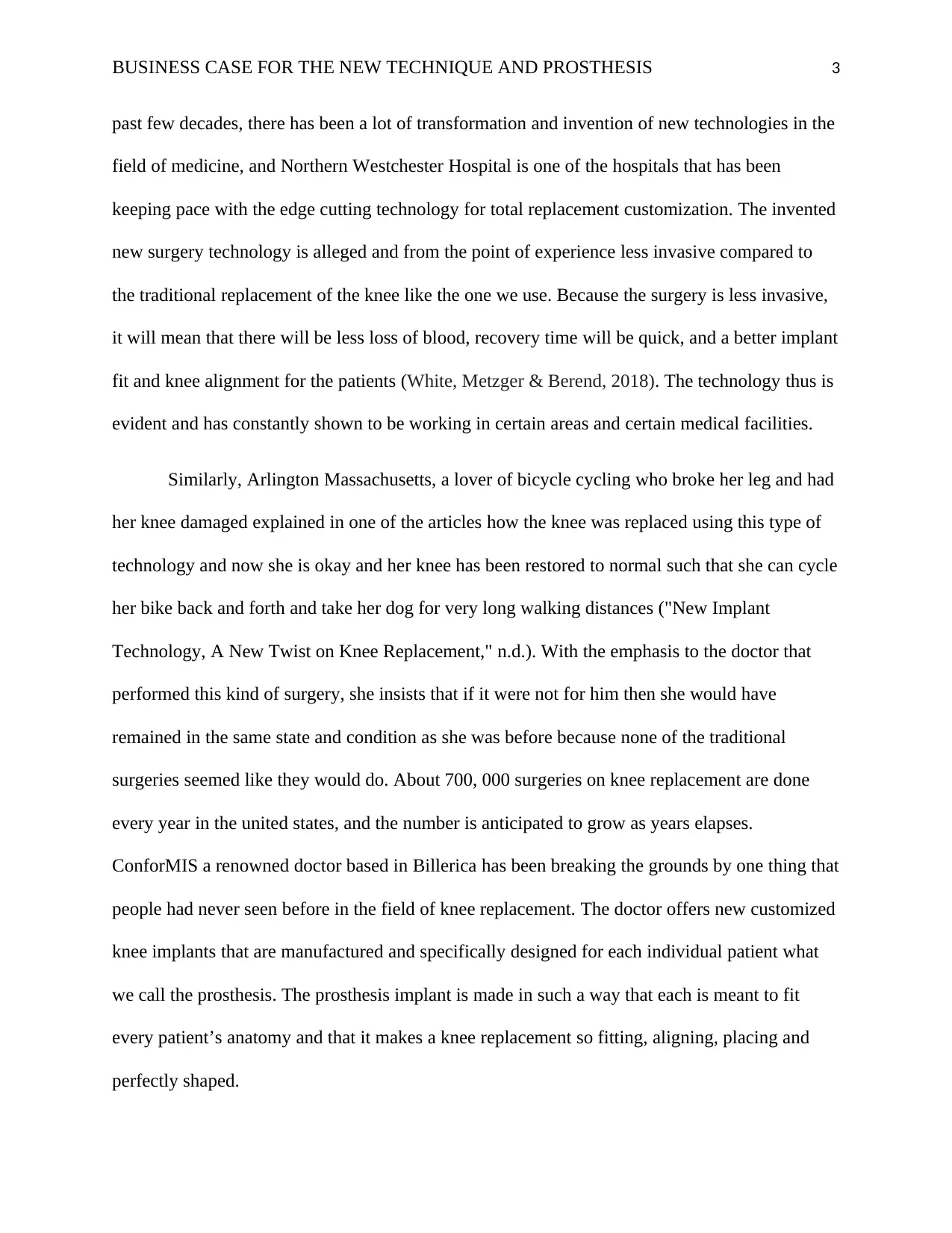
BUSINESS CASE FOR THE NEW TECHNIQUE AND PROSTHESIS 3
past few decades, there has been a lot of transformation and invention of new technologies in the
field of medicine, and Northern Westchester Hospital is one of the hospitals that has been
keeping pace with the edge cutting technology for total replacement customization. The invented
new surgery technology is alleged and from the point of experience less invasive compared to
the traditional replacement of the knee like the one we use. Because the surgery is less invasive,
it will mean that there will be less loss of blood, recovery time will be quick, and a better implant
fit and knee alignment for the patients (White, Metzger & Berend, 2018). The technology thus is
evident and has constantly shown to be working in certain areas and certain medical facilities.
Similarly, Arlington Massachusetts, a lover of bicycle cycling who broke her leg and had
her knee damaged explained in one of the articles how the knee was replaced using this type of
technology and now she is okay and her knee has been restored to normal such that she can cycle
her bike back and forth and take her dog for very long walking distances ("New Implant
Technology, A New Twist on Knee Replacement," n.d.). With the emphasis to the doctor that
performed this kind of surgery, she insists that if it were not for him then she would have
remained in the same state and condition as she was before because none of the traditional
surgeries seemed like they would do. About 700, 000 surgeries on knee replacement are done
every year in the united states, and the number is anticipated to grow as years elapses.
ConforMIS a renowned doctor based in Billerica has been breaking the grounds by one thing that
people had never seen before in the field of knee replacement. The doctor offers new customized
knee implants that are manufactured and specifically designed for each individual patient what
we call the prosthesis. The prosthesis implant is made in such a way that each is meant to fit
every patient’s anatomy and that it makes a knee replacement so fitting, aligning, placing and
perfectly shaped.
past few decades, there has been a lot of transformation and invention of new technologies in the
field of medicine, and Northern Westchester Hospital is one of the hospitals that has been
keeping pace with the edge cutting technology for total replacement customization. The invented
new surgery technology is alleged and from the point of experience less invasive compared to
the traditional replacement of the knee like the one we use. Because the surgery is less invasive,
it will mean that there will be less loss of blood, recovery time will be quick, and a better implant
fit and knee alignment for the patients (White, Metzger & Berend, 2018). The technology thus is
evident and has constantly shown to be working in certain areas and certain medical facilities.
Similarly, Arlington Massachusetts, a lover of bicycle cycling who broke her leg and had
her knee damaged explained in one of the articles how the knee was replaced using this type of
technology and now she is okay and her knee has been restored to normal such that she can cycle
her bike back and forth and take her dog for very long walking distances ("New Implant
Technology, A New Twist on Knee Replacement," n.d.). With the emphasis to the doctor that
performed this kind of surgery, she insists that if it were not for him then she would have
remained in the same state and condition as she was before because none of the traditional
surgeries seemed like they would do. About 700, 000 surgeries on knee replacement are done
every year in the united states, and the number is anticipated to grow as years elapses.
ConforMIS a renowned doctor based in Billerica has been breaking the grounds by one thing that
people had never seen before in the field of knee replacement. The doctor offers new customized
knee implants that are manufactured and specifically designed for each individual patient what
we call the prosthesis. The prosthesis implant is made in such a way that each is meant to fit
every patient’s anatomy and that it makes a knee replacement so fitting, aligning, placing and
perfectly shaped.
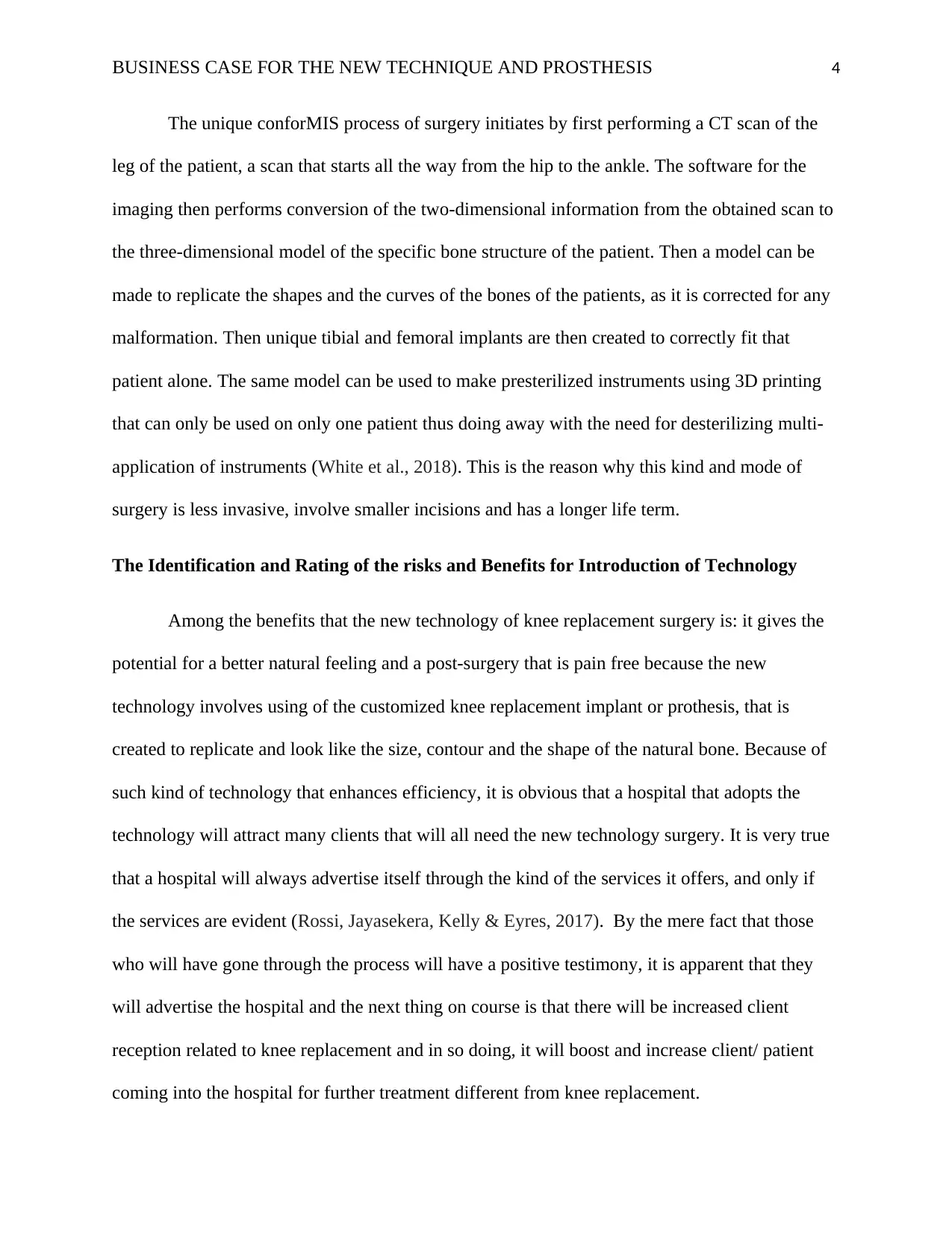
BUSINESS CASE FOR THE NEW TECHNIQUE AND PROSTHESIS 4
The unique conforMIS process of surgery initiates by first performing a CT scan of the
leg of the patient, a scan that starts all the way from the hip to the ankle. The software for the
imaging then performs conversion of the two-dimensional information from the obtained scan to
the three-dimensional model of the specific bone structure of the patient. Then a model can be
made to replicate the shapes and the curves of the bones of the patients, as it is corrected for any
malformation. Then unique tibial and femoral implants are then created to correctly fit that
patient alone. The same model can be used to make presterilized instruments using 3D printing
that can only be used on only one patient thus doing away with the need for desterilizing multi-
application of instruments (White et al., 2018). This is the reason why this kind and mode of
surgery is less invasive, involve smaller incisions and has a longer life term.
The Identification and Rating of the risks and Benefits for Introduction of Technology
Among the benefits that the new technology of knee replacement surgery is: it gives the
potential for a better natural feeling and a post-surgery that is pain free because the new
technology involves using of the customized knee replacement implant or prothesis, that is
created to replicate and look like the size, contour and the shape of the natural bone. Because of
such kind of technology that enhances efficiency, it is obvious that a hospital that adopts the
technology will attract many clients that will all need the new technology surgery. It is very true
that a hospital will always advertise itself through the kind of the services it offers, and only if
the services are evident (Rossi, Jayasekera, Kelly & Eyres, 2017). By the mere fact that those
who will have gone through the process will have a positive testimony, it is apparent that they
will advertise the hospital and the next thing on course is that there will be increased client
reception related to knee replacement and in so doing, it will boost and increase client/ patient
coming into the hospital for further treatment different from knee replacement.
The unique conforMIS process of surgery initiates by first performing a CT scan of the
leg of the patient, a scan that starts all the way from the hip to the ankle. The software for the
imaging then performs conversion of the two-dimensional information from the obtained scan to
the three-dimensional model of the specific bone structure of the patient. Then a model can be
made to replicate the shapes and the curves of the bones of the patients, as it is corrected for any
malformation. Then unique tibial and femoral implants are then created to correctly fit that
patient alone. The same model can be used to make presterilized instruments using 3D printing
that can only be used on only one patient thus doing away with the need for desterilizing multi-
application of instruments (White et al., 2018). This is the reason why this kind and mode of
surgery is less invasive, involve smaller incisions and has a longer life term.
The Identification and Rating of the risks and Benefits for Introduction of Technology
Among the benefits that the new technology of knee replacement surgery is: it gives the
potential for a better natural feeling and a post-surgery that is pain free because the new
technology involves using of the customized knee replacement implant or prothesis, that is
created to replicate and look like the size, contour and the shape of the natural bone. Because of
such kind of technology that enhances efficiency, it is obvious that a hospital that adopts the
technology will attract many clients that will all need the new technology surgery. It is very true
that a hospital will always advertise itself through the kind of the services it offers, and only if
the services are evident (Rossi, Jayasekera, Kelly & Eyres, 2017). By the mere fact that those
who will have gone through the process will have a positive testimony, it is apparent that they
will advertise the hospital and the next thing on course is that there will be increased client
reception related to knee replacement and in so doing, it will boost and increase client/ patient
coming into the hospital for further treatment different from knee replacement.
Secure Best Marks with AI Grader
Need help grading? Try our AI Grader for instant feedback on your assignments.
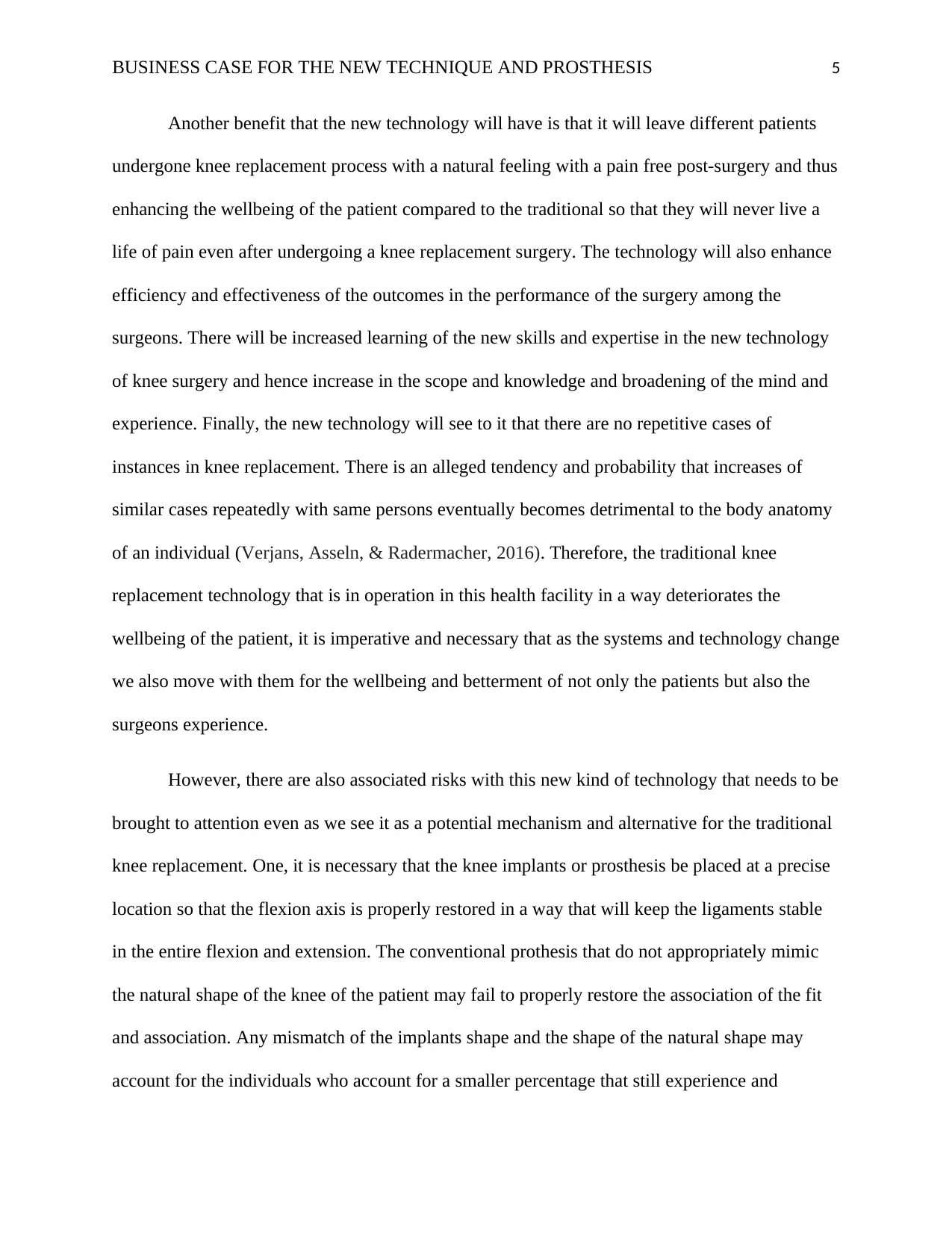
BUSINESS CASE FOR THE NEW TECHNIQUE AND PROSTHESIS 5
Another benefit that the new technology will have is that it will leave different patients
undergone knee replacement process with a natural feeling with a pain free post-surgery and thus
enhancing the wellbeing of the patient compared to the traditional so that they will never live a
life of pain even after undergoing a knee replacement surgery. The technology will also enhance
efficiency and effectiveness of the outcomes in the performance of the surgery among the
surgeons. There will be increased learning of the new skills and expertise in the new technology
of knee surgery and hence increase in the scope and knowledge and broadening of the mind and
experience. Finally, the new technology will see to it that there are no repetitive cases of
instances in knee replacement. There is an alleged tendency and probability that increases of
similar cases repeatedly with same persons eventually becomes detrimental to the body anatomy
of an individual (Verjans, Asseln, & Radermacher, 2016). Therefore, the traditional knee
replacement technology that is in operation in this health facility in a way deteriorates the
wellbeing of the patient, it is imperative and necessary that as the systems and technology change
we also move with them for the wellbeing and betterment of not only the patients but also the
surgeons experience.
However, there are also associated risks with this new kind of technology that needs to be
brought to attention even as we see it as a potential mechanism and alternative for the traditional
knee replacement. One, it is necessary that the knee implants or prosthesis be placed at a precise
location so that the flexion axis is properly restored in a way that will keep the ligaments stable
in the entire flexion and extension. The conventional prothesis that do not appropriately mimic
the natural shape of the knee of the patient may fail to properly restore the association of the fit
and association. Any mismatch of the implants shape and the shape of the natural shape may
account for the individuals who account for a smaller percentage that still experience and
Another benefit that the new technology will have is that it will leave different patients
undergone knee replacement process with a natural feeling with a pain free post-surgery and thus
enhancing the wellbeing of the patient compared to the traditional so that they will never live a
life of pain even after undergoing a knee replacement surgery. The technology will also enhance
efficiency and effectiveness of the outcomes in the performance of the surgery among the
surgeons. There will be increased learning of the new skills and expertise in the new technology
of knee surgery and hence increase in the scope and knowledge and broadening of the mind and
experience. Finally, the new technology will see to it that there are no repetitive cases of
instances in knee replacement. There is an alleged tendency and probability that increases of
similar cases repeatedly with same persons eventually becomes detrimental to the body anatomy
of an individual (Verjans, Asseln, & Radermacher, 2016). Therefore, the traditional knee
replacement technology that is in operation in this health facility in a way deteriorates the
wellbeing of the patient, it is imperative and necessary that as the systems and technology change
we also move with them for the wellbeing and betterment of not only the patients but also the
surgeons experience.
However, there are also associated risks with this new kind of technology that needs to be
brought to attention even as we see it as a potential mechanism and alternative for the traditional
knee replacement. One, it is necessary that the knee implants or prosthesis be placed at a precise
location so that the flexion axis is properly restored in a way that will keep the ligaments stable
in the entire flexion and extension. The conventional prothesis that do not appropriately mimic
the natural shape of the knee of the patient may fail to properly restore the association of the fit
and association. Any mismatch of the implants shape and the shape of the natural shape may
account for the individuals who account for a smaller percentage that still experience and
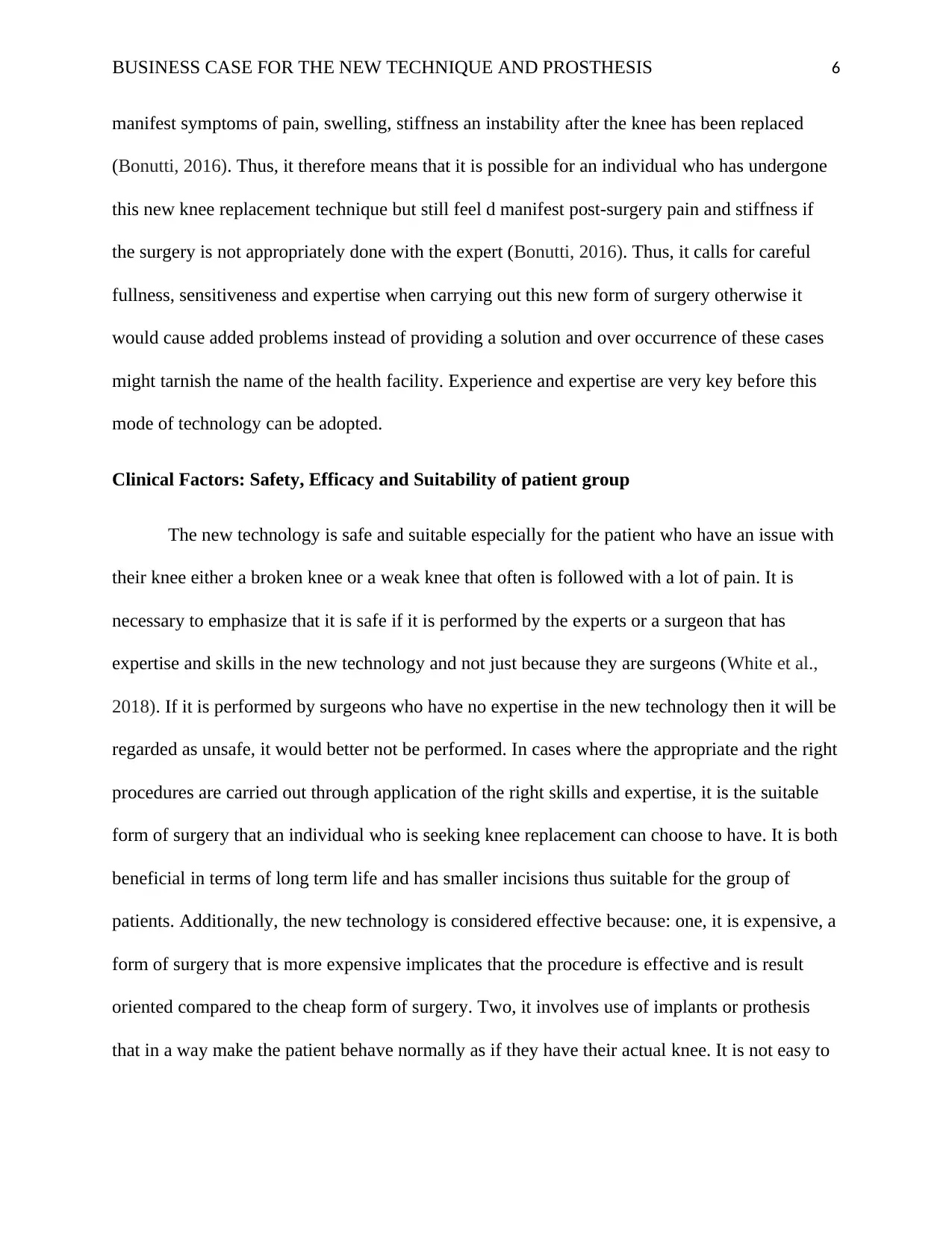
BUSINESS CASE FOR THE NEW TECHNIQUE AND PROSTHESIS 6
manifest symptoms of pain, swelling, stiffness an instability after the knee has been replaced
(Bonutti, 2016). Thus, it therefore means that it is possible for an individual who has undergone
this new knee replacement technique but still feel d manifest post-surgery pain and stiffness if
the surgery is not appropriately done with the expert (Bonutti, 2016). Thus, it calls for careful
fullness, sensitiveness and expertise when carrying out this new form of surgery otherwise it
would cause added problems instead of providing a solution and over occurrence of these cases
might tarnish the name of the health facility. Experience and expertise are very key before this
mode of technology can be adopted.
Clinical Factors: Safety, Efficacy and Suitability of patient group
The new technology is safe and suitable especially for the patient who have an issue with
their knee either a broken knee or a weak knee that often is followed with a lot of pain. It is
necessary to emphasize that it is safe if it is performed by the experts or a surgeon that has
expertise and skills in the new technology and not just because they are surgeons (White et al.,
2018). If it is performed by surgeons who have no expertise in the new technology then it will be
regarded as unsafe, it would better not be performed. In cases where the appropriate and the right
procedures are carried out through application of the right skills and expertise, it is the suitable
form of surgery that an individual who is seeking knee replacement can choose to have. It is both
beneficial in terms of long term life and has smaller incisions thus suitable for the group of
patients. Additionally, the new technology is considered effective because: one, it is expensive, a
form of surgery that is more expensive implicates that the procedure is effective and is result
oriented compared to the cheap form of surgery. Two, it involves use of implants or prothesis
that in a way make the patient behave normally as if they have their actual knee. It is not easy to
manifest symptoms of pain, swelling, stiffness an instability after the knee has been replaced
(Bonutti, 2016). Thus, it therefore means that it is possible for an individual who has undergone
this new knee replacement technique but still feel d manifest post-surgery pain and stiffness if
the surgery is not appropriately done with the expert (Bonutti, 2016). Thus, it calls for careful
fullness, sensitiveness and expertise when carrying out this new form of surgery otherwise it
would cause added problems instead of providing a solution and over occurrence of these cases
might tarnish the name of the health facility. Experience and expertise are very key before this
mode of technology can be adopted.
Clinical Factors: Safety, Efficacy and Suitability of patient group
The new technology is safe and suitable especially for the patient who have an issue with
their knee either a broken knee or a weak knee that often is followed with a lot of pain. It is
necessary to emphasize that it is safe if it is performed by the experts or a surgeon that has
expertise and skills in the new technology and not just because they are surgeons (White et al.,
2018). If it is performed by surgeons who have no expertise in the new technology then it will be
regarded as unsafe, it would better not be performed. In cases where the appropriate and the right
procedures are carried out through application of the right skills and expertise, it is the suitable
form of surgery that an individual who is seeking knee replacement can choose to have. It is both
beneficial in terms of long term life and has smaller incisions thus suitable for the group of
patients. Additionally, the new technology is considered effective because: one, it is expensive, a
form of surgery that is more expensive implicates that the procedure is effective and is result
oriented compared to the cheap form of surgery. Two, it involves use of implants or prothesis
that in a way make the patient behave normally as if they have their actual knee. It is not easy to
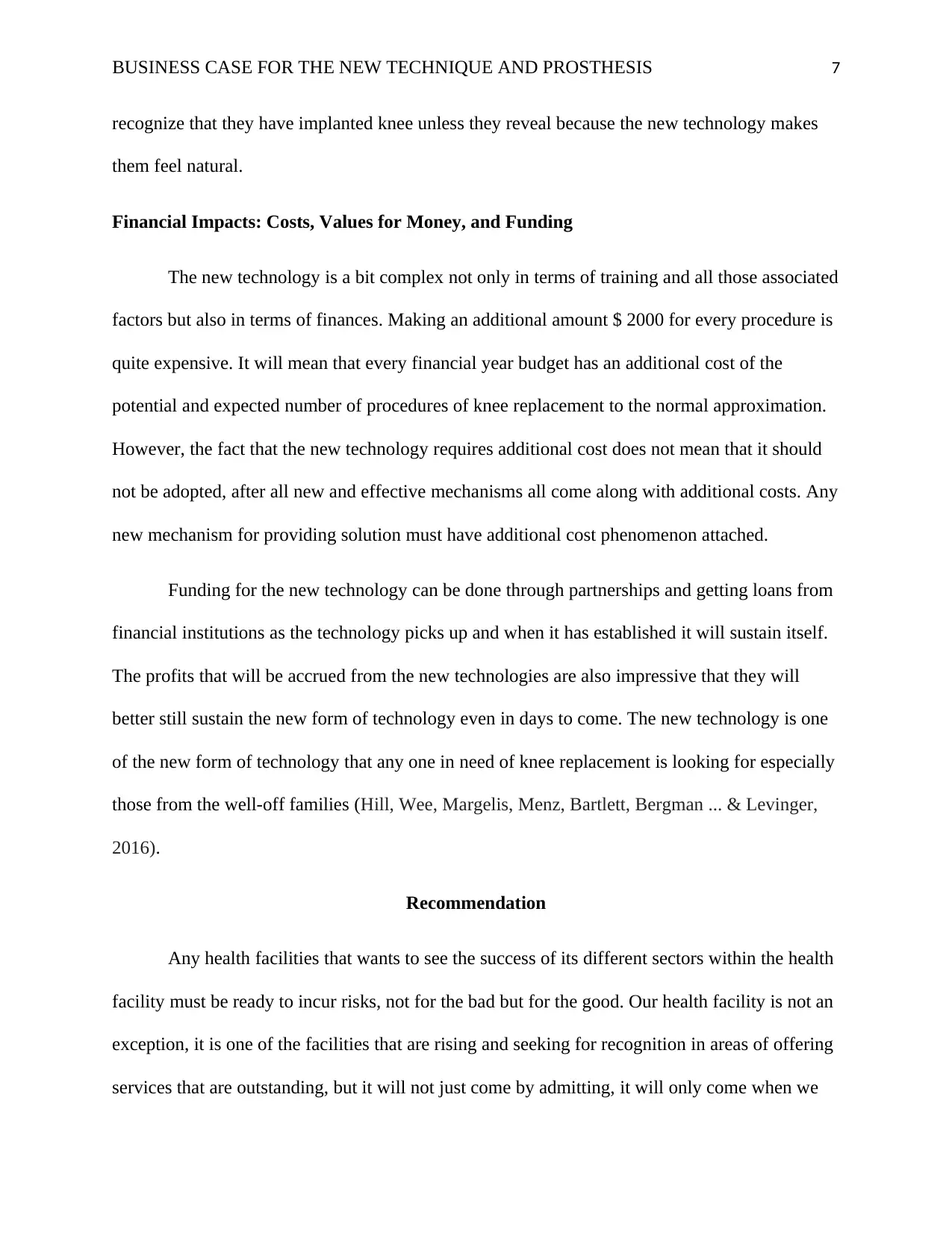
BUSINESS CASE FOR THE NEW TECHNIQUE AND PROSTHESIS 7
recognize that they have implanted knee unless they reveal because the new technology makes
them feel natural.
Financial Impacts: Costs, Values for Money, and Funding
The new technology is a bit complex not only in terms of training and all those associated
factors but also in terms of finances. Making an additional amount $ 2000 for every procedure is
quite expensive. It will mean that every financial year budget has an additional cost of the
potential and expected number of procedures of knee replacement to the normal approximation.
However, the fact that the new technology requires additional cost does not mean that it should
not be adopted, after all new and effective mechanisms all come along with additional costs. Any
new mechanism for providing solution must have additional cost phenomenon attached.
Funding for the new technology can be done through partnerships and getting loans from
financial institutions as the technology picks up and when it has established it will sustain itself.
The profits that will be accrued from the new technologies are also impressive that they will
better still sustain the new form of technology even in days to come. The new technology is one
of the new form of technology that any one in need of knee replacement is looking for especially
those from the well-off families (Hill, Wee, Margelis, Menz, Bartlett, Bergman ... & Levinger,
2016).
Recommendation
Any health facilities that wants to see the success of its different sectors within the health
facility must be ready to incur risks, not for the bad but for the good. Our health facility is not an
exception, it is one of the facilities that are rising and seeking for recognition in areas of offering
services that are outstanding, but it will not just come by admitting, it will only come when we
recognize that they have implanted knee unless they reveal because the new technology makes
them feel natural.
Financial Impacts: Costs, Values for Money, and Funding
The new technology is a bit complex not only in terms of training and all those associated
factors but also in terms of finances. Making an additional amount $ 2000 for every procedure is
quite expensive. It will mean that every financial year budget has an additional cost of the
potential and expected number of procedures of knee replacement to the normal approximation.
However, the fact that the new technology requires additional cost does not mean that it should
not be adopted, after all new and effective mechanisms all come along with additional costs. Any
new mechanism for providing solution must have additional cost phenomenon attached.
Funding for the new technology can be done through partnerships and getting loans from
financial institutions as the technology picks up and when it has established it will sustain itself.
The profits that will be accrued from the new technologies are also impressive that they will
better still sustain the new form of technology even in days to come. The new technology is one
of the new form of technology that any one in need of knee replacement is looking for especially
those from the well-off families (Hill, Wee, Margelis, Menz, Bartlett, Bergman ... & Levinger,
2016).
Recommendation
Any health facilities that wants to see the success of its different sectors within the health
facility must be ready to incur risks, not for the bad but for the good. Our health facility is not an
exception, it is one of the facilities that are rising and seeking for recognition in areas of offering
services that are outstanding, but it will not just come by admitting, it will only come when we
Paraphrase This Document
Need a fresh take? Get an instant paraphrase of this document with our AI Paraphraser
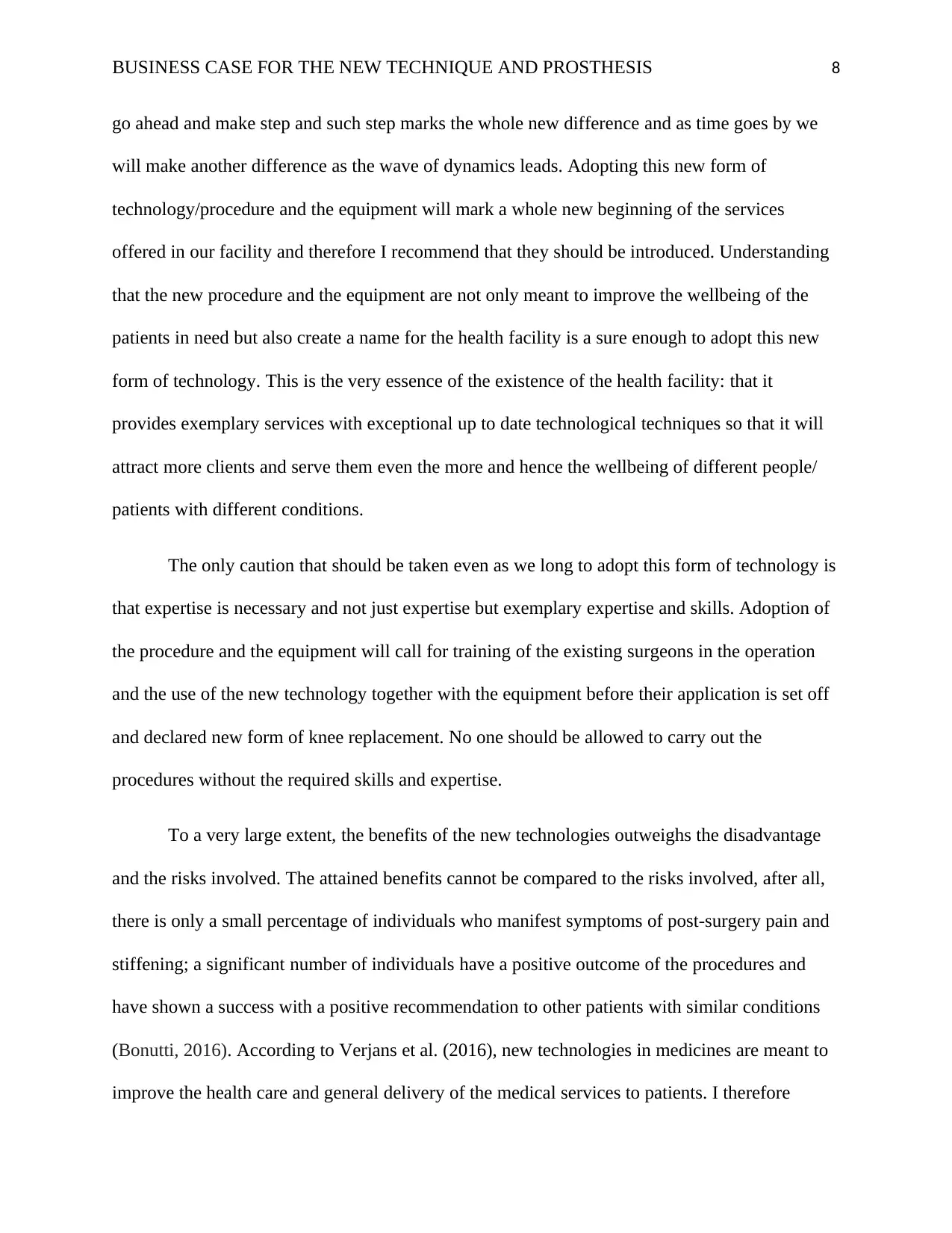
BUSINESS CASE FOR THE NEW TECHNIQUE AND PROSTHESIS 8
go ahead and make step and such step marks the whole new difference and as time goes by we
will make another difference as the wave of dynamics leads. Adopting this new form of
technology/procedure and the equipment will mark a whole new beginning of the services
offered in our facility and therefore I recommend that they should be introduced. Understanding
that the new procedure and the equipment are not only meant to improve the wellbeing of the
patients in need but also create a name for the health facility is a sure enough to adopt this new
form of technology. This is the very essence of the existence of the health facility: that it
provides exemplary services with exceptional up to date technological techniques so that it will
attract more clients and serve them even the more and hence the wellbeing of different people/
patients with different conditions.
The only caution that should be taken even as we long to adopt this form of technology is
that expertise is necessary and not just expertise but exemplary expertise and skills. Adoption of
the procedure and the equipment will call for training of the existing surgeons in the operation
and the use of the new technology together with the equipment before their application is set off
and declared new form of knee replacement. No one should be allowed to carry out the
procedures without the required skills and expertise.
To a very large extent, the benefits of the new technologies outweighs the disadvantage
and the risks involved. The attained benefits cannot be compared to the risks involved, after all,
there is only a small percentage of individuals who manifest symptoms of post-surgery pain and
stiffening; a significant number of individuals have a positive outcome of the procedures and
have shown a success with a positive recommendation to other patients with similar conditions
(Bonutti, 2016). According to Verjans et al. (2016), new technologies in medicines are meant to
improve the health care and general delivery of the medical services to patients. I therefore
go ahead and make step and such step marks the whole new difference and as time goes by we
will make another difference as the wave of dynamics leads. Adopting this new form of
technology/procedure and the equipment will mark a whole new beginning of the services
offered in our facility and therefore I recommend that they should be introduced. Understanding
that the new procedure and the equipment are not only meant to improve the wellbeing of the
patients in need but also create a name for the health facility is a sure enough to adopt this new
form of technology. This is the very essence of the existence of the health facility: that it
provides exemplary services with exceptional up to date technological techniques so that it will
attract more clients and serve them even the more and hence the wellbeing of different people/
patients with different conditions.
The only caution that should be taken even as we long to adopt this form of technology is
that expertise is necessary and not just expertise but exemplary expertise and skills. Adoption of
the procedure and the equipment will call for training of the existing surgeons in the operation
and the use of the new technology together with the equipment before their application is set off
and declared new form of knee replacement. No one should be allowed to carry out the
procedures without the required skills and expertise.
To a very large extent, the benefits of the new technologies outweighs the disadvantage
and the risks involved. The attained benefits cannot be compared to the risks involved, after all,
there is only a small percentage of individuals who manifest symptoms of post-surgery pain and
stiffening; a significant number of individuals have a positive outcome of the procedures and
have shown a success with a positive recommendation to other patients with similar conditions
(Bonutti, 2016). According to Verjans et al. (2016), new technologies in medicines are meant to
improve the health care and general delivery of the medical services to patients. I therefore
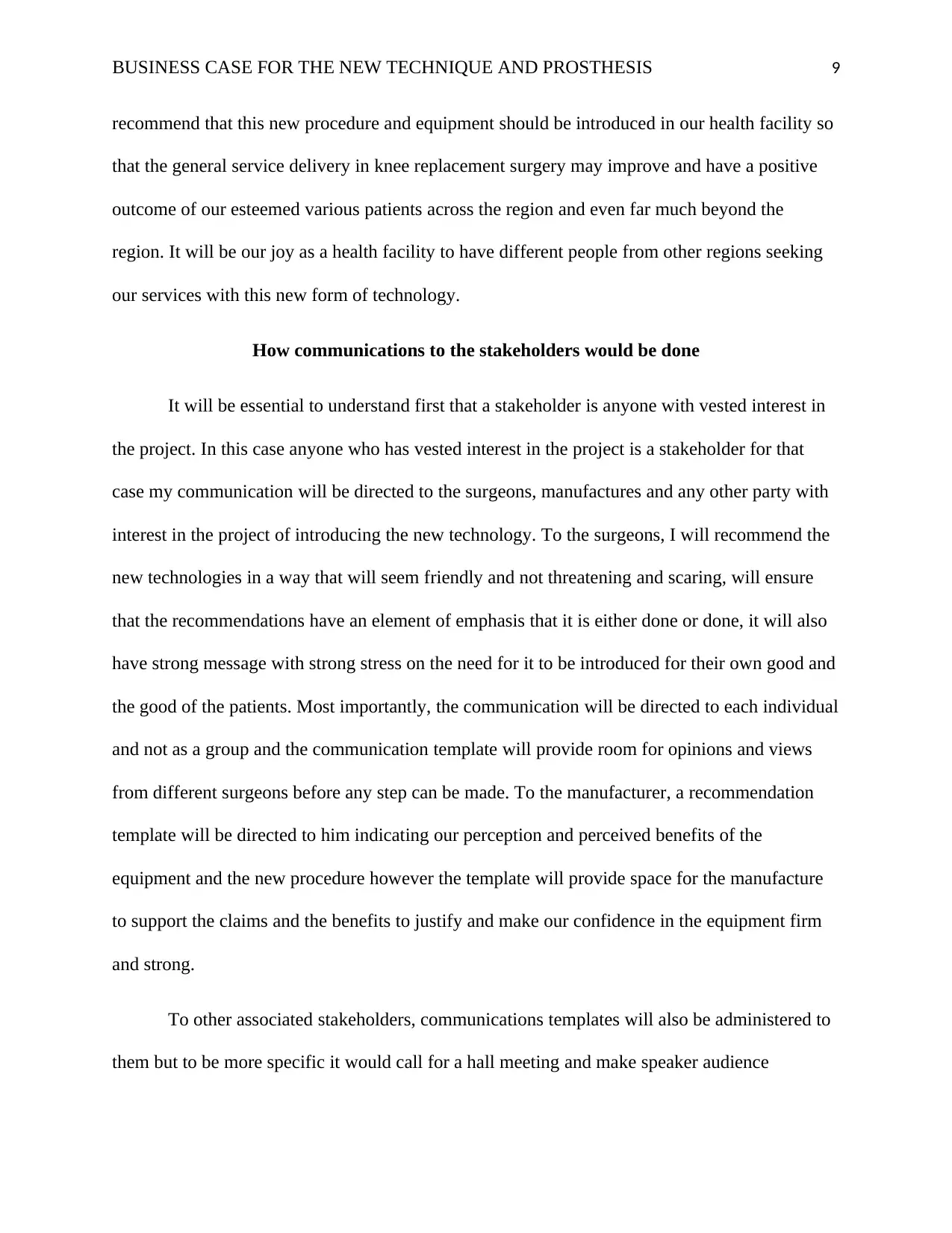
BUSINESS CASE FOR THE NEW TECHNIQUE AND PROSTHESIS 9
recommend that this new procedure and equipment should be introduced in our health facility so
that the general service delivery in knee replacement surgery may improve and have a positive
outcome of our esteemed various patients across the region and even far much beyond the
region. It will be our joy as a health facility to have different people from other regions seeking
our services with this new form of technology.
How communications to the stakeholders would be done
It will be essential to understand first that a stakeholder is anyone with vested interest in
the project. In this case anyone who has vested interest in the project is a stakeholder for that
case my communication will be directed to the surgeons, manufactures and any other party with
interest in the project of introducing the new technology. To the surgeons, I will recommend the
new technologies in a way that will seem friendly and not threatening and scaring, will ensure
that the recommendations have an element of emphasis that it is either done or done, it will also
have strong message with strong stress on the need for it to be introduced for their own good and
the good of the patients. Most importantly, the communication will be directed to each individual
and not as a group and the communication template will provide room for opinions and views
from different surgeons before any step can be made. To the manufacturer, a recommendation
template will be directed to him indicating our perception and perceived benefits of the
equipment and the new procedure however the template will provide space for the manufacture
to support the claims and the benefits to justify and make our confidence in the equipment firm
and strong.
To other associated stakeholders, communications templates will also be administered to
them but to be more specific it would call for a hall meeting and make speaker audience
recommend that this new procedure and equipment should be introduced in our health facility so
that the general service delivery in knee replacement surgery may improve and have a positive
outcome of our esteemed various patients across the region and even far much beyond the
region. It will be our joy as a health facility to have different people from other regions seeking
our services with this new form of technology.
How communications to the stakeholders would be done
It will be essential to understand first that a stakeholder is anyone with vested interest in
the project. In this case anyone who has vested interest in the project is a stakeholder for that
case my communication will be directed to the surgeons, manufactures and any other party with
interest in the project of introducing the new technology. To the surgeons, I will recommend the
new technologies in a way that will seem friendly and not threatening and scaring, will ensure
that the recommendations have an element of emphasis that it is either done or done, it will also
have strong message with strong stress on the need for it to be introduced for their own good and
the good of the patients. Most importantly, the communication will be directed to each individual
and not as a group and the communication template will provide room for opinions and views
from different surgeons before any step can be made. To the manufacturer, a recommendation
template will be directed to him indicating our perception and perceived benefits of the
equipment and the new procedure however the template will provide space for the manufacture
to support the claims and the benefits to justify and make our confidence in the equipment firm
and strong.
To other associated stakeholders, communications templates will also be administered to
them but to be more specific it would call for a hall meeting and make speaker audience
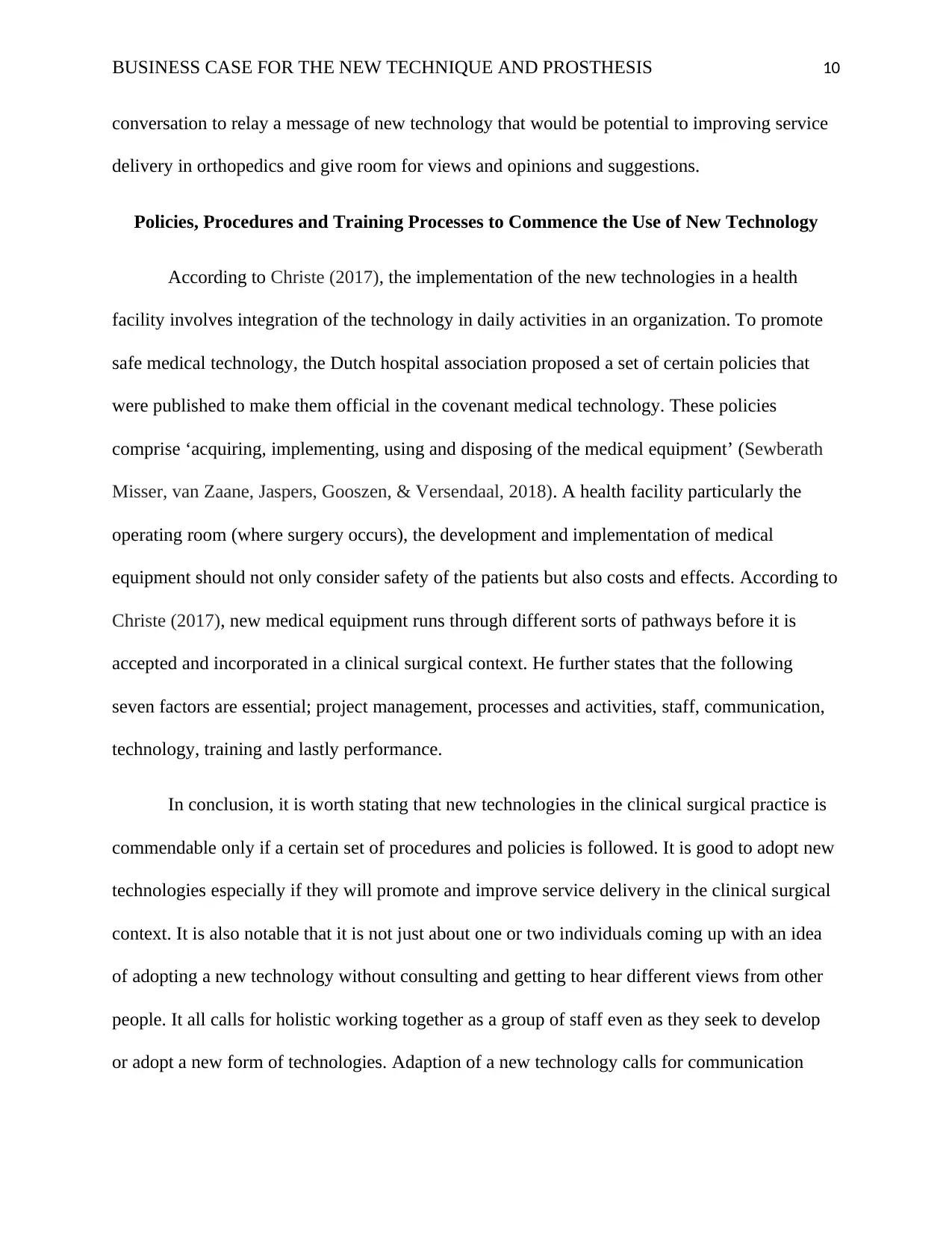
BUSINESS CASE FOR THE NEW TECHNIQUE AND PROSTHESIS 10
conversation to relay a message of new technology that would be potential to improving service
delivery in orthopedics and give room for views and opinions and suggestions.
Policies, Procedures and Training Processes to Commence the Use of New Technology
According to Christe (2017), the implementation of the new technologies in a health
facility involves integration of the technology in daily activities in an organization. To promote
safe medical technology, the Dutch hospital association proposed a set of certain policies that
were published to make them official in the covenant medical technology. These policies
comprise ‘acquiring, implementing, using and disposing of the medical equipment’ (Sewberath
Misser, van Zaane, Jaspers, Gooszen, & Versendaal, 2018). A health facility particularly the
operating room (where surgery occurs), the development and implementation of medical
equipment should not only consider safety of the patients but also costs and effects. According to
Christe (2017), new medical equipment runs through different sorts of pathways before it is
accepted and incorporated in a clinical surgical context. He further states that the following
seven factors are essential; project management, processes and activities, staff, communication,
technology, training and lastly performance.
In conclusion, it is worth stating that new technologies in the clinical surgical practice is
commendable only if a certain set of procedures and policies is followed. It is good to adopt new
technologies especially if they will promote and improve service delivery in the clinical surgical
context. It is also notable that it is not just about one or two individuals coming up with an idea
of adopting a new technology without consulting and getting to hear different views from other
people. It all calls for holistic working together as a group of staff even as they seek to develop
or adopt a new form of technologies. Adaption of a new technology calls for communication
conversation to relay a message of new technology that would be potential to improving service
delivery in orthopedics and give room for views and opinions and suggestions.
Policies, Procedures and Training Processes to Commence the Use of New Technology
According to Christe (2017), the implementation of the new technologies in a health
facility involves integration of the technology in daily activities in an organization. To promote
safe medical technology, the Dutch hospital association proposed a set of certain policies that
were published to make them official in the covenant medical technology. These policies
comprise ‘acquiring, implementing, using and disposing of the medical equipment’ (Sewberath
Misser, van Zaane, Jaspers, Gooszen, & Versendaal, 2018). A health facility particularly the
operating room (where surgery occurs), the development and implementation of medical
equipment should not only consider safety of the patients but also costs and effects. According to
Christe (2017), new medical equipment runs through different sorts of pathways before it is
accepted and incorporated in a clinical surgical context. He further states that the following
seven factors are essential; project management, processes and activities, staff, communication,
technology, training and lastly performance.
In conclusion, it is worth stating that new technologies in the clinical surgical practice is
commendable only if a certain set of procedures and policies is followed. It is good to adopt new
technologies especially if they will promote and improve service delivery in the clinical surgical
context. It is also notable that it is not just about one or two individuals coming up with an idea
of adopting a new technology without consulting and getting to hear different views from other
people. It all calls for holistic working together as a group of staff even as they seek to develop
or adopt a new form of technologies. Adaption of a new technology calls for communication
Secure Best Marks with AI Grader
Need help grading? Try our AI Grader for instant feedback on your assignments.

BUSINESS CASE FOR THE NEW TECHNIQUE AND PROSTHESIS 11
among all the stakeholders as key concept in the health facility. With the right channel of
communication, adoption of a new technology is achievable.
among all the stakeholders as key concept in the health facility. With the right channel of
communication, adoption of a new technology is achievable.
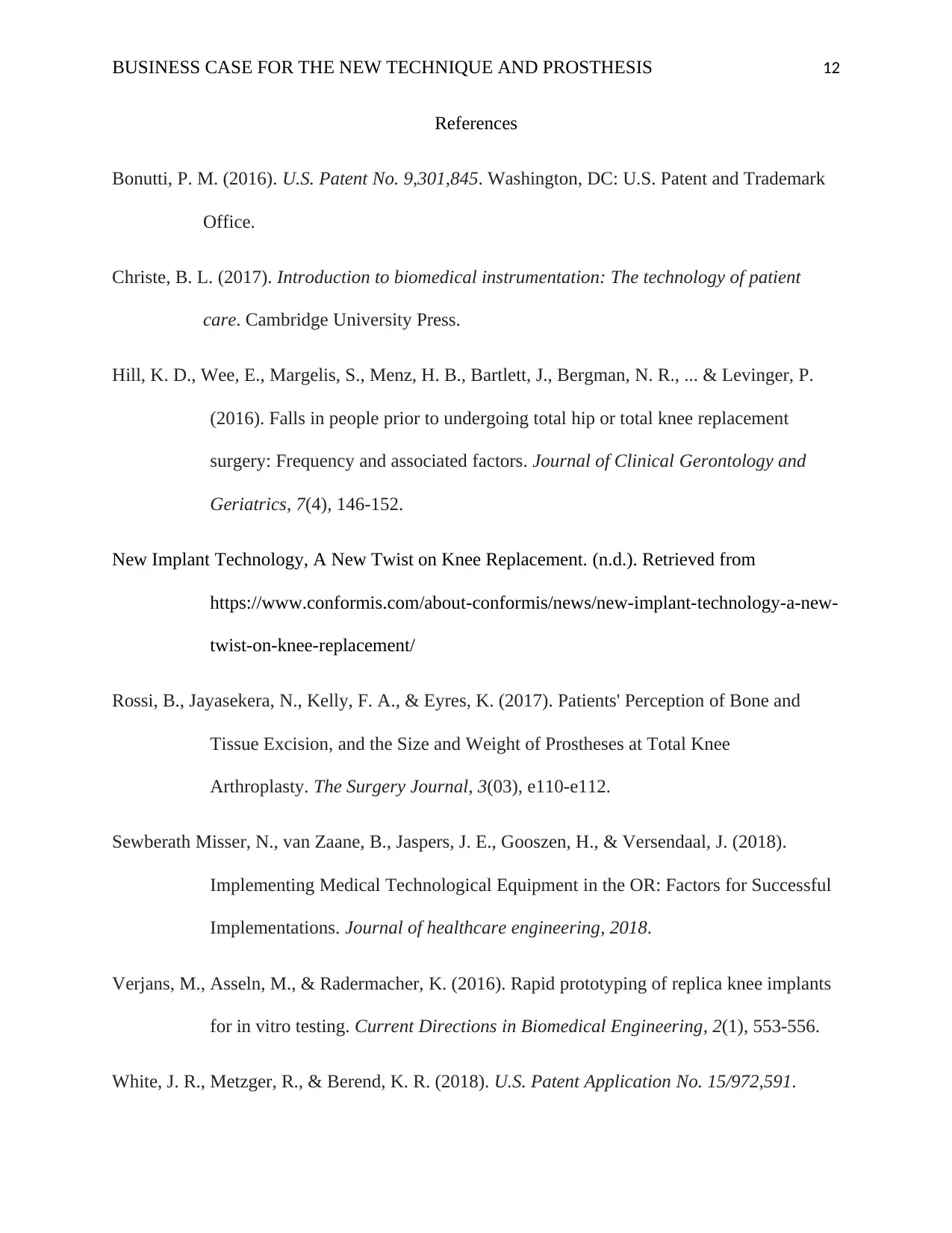
BUSINESS CASE FOR THE NEW TECHNIQUE AND PROSTHESIS 12
References
Bonutti, P. M. (2016). U.S. Patent No. 9,301,845. Washington, DC: U.S. Patent and Trademark
Office.
Christe, B. L. (2017). Introduction to biomedical instrumentation: The technology of patient
care. Cambridge University Press.
Hill, K. D., Wee, E., Margelis, S., Menz, H. B., Bartlett, J., Bergman, N. R., ... & Levinger, P.
(2016). Falls in people prior to undergoing total hip or total knee replacement
surgery: Frequency and associated factors. Journal of Clinical Gerontology and
Geriatrics, 7(4), 146-152.
New Implant Technology, A New Twist on Knee Replacement. (n.d.). Retrieved from
https://www.conformis.com/about-conformis/news/new-implant-technology-a-new-
twist-on-knee-replacement/
Rossi, B., Jayasekera, N., Kelly, F. A., & Eyres, K. (2017). Patients' Perception of Bone and
Tissue Excision, and the Size and Weight of Prostheses at Total Knee
Arthroplasty. The Surgery Journal, 3(03), e110-e112.
Sewberath Misser, N., van Zaane, B., Jaspers, J. E., Gooszen, H., & Versendaal, J. (2018).
Implementing Medical Technological Equipment in the OR: Factors for Successful
Implementations. Journal of healthcare engineering, 2018.
Verjans, M., Asseln, M., & Radermacher, K. (2016). Rapid prototyping of replica knee implants
for in vitro testing. Current Directions in Biomedical Engineering, 2(1), 553-556.
White, J. R., Metzger, R., & Berend, K. R. (2018). U.S. Patent Application No. 15/972,591.
References
Bonutti, P. M. (2016). U.S. Patent No. 9,301,845. Washington, DC: U.S. Patent and Trademark
Office.
Christe, B. L. (2017). Introduction to biomedical instrumentation: The technology of patient
care. Cambridge University Press.
Hill, K. D., Wee, E., Margelis, S., Menz, H. B., Bartlett, J., Bergman, N. R., ... & Levinger, P.
(2016). Falls in people prior to undergoing total hip or total knee replacement
surgery: Frequency and associated factors. Journal of Clinical Gerontology and
Geriatrics, 7(4), 146-152.
New Implant Technology, A New Twist on Knee Replacement. (n.d.). Retrieved from
https://www.conformis.com/about-conformis/news/new-implant-technology-a-new-
twist-on-knee-replacement/
Rossi, B., Jayasekera, N., Kelly, F. A., & Eyres, K. (2017). Patients' Perception of Bone and
Tissue Excision, and the Size and Weight of Prostheses at Total Knee
Arthroplasty. The Surgery Journal, 3(03), e110-e112.
Sewberath Misser, N., van Zaane, B., Jaspers, J. E., Gooszen, H., & Versendaal, J. (2018).
Implementing Medical Technological Equipment in the OR: Factors for Successful
Implementations. Journal of healthcare engineering, 2018.
Verjans, M., Asseln, M., & Radermacher, K. (2016). Rapid prototyping of replica knee implants
for in vitro testing. Current Directions in Biomedical Engineering, 2(1), 553-556.
White, J. R., Metzger, R., & Berend, K. R. (2018). U.S. Patent Application No. 15/972,591.

BUSINESS CASE FOR THE NEW TECHNIQUE AND PROSTHESIS 13
1 out of 13
Your All-in-One AI-Powered Toolkit for Academic Success.
+13062052269
info@desklib.com
Available 24*7 on WhatsApp / Email
![[object Object]](/_next/static/media/star-bottom.7253800d.svg)
Unlock your academic potential
© 2024 | Zucol Services PVT LTD | All rights reserved.


